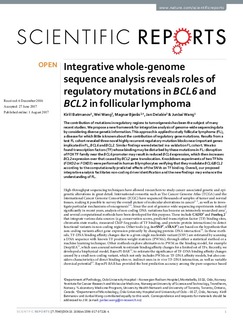| dc.contributor.author | Batmanov, Kirill | |
| dc.contributor.author | Wang, Wei | |
| dc.contributor.author | Bjørås, Magnar | |
| dc.contributor.author | Delabie, Jan | |
| dc.contributor.author | Wang, Junbai | |
| dc.date.accessioned | 2018-02-15T14:28:35Z | |
| dc.date.available | 2018-02-15T14:28:35Z | |
| dc.date.created | 2017-08-09T15:26:47Z | |
| dc.date.issued | 2017 | |
| dc.identifier.citation | Scientific Reports, 7:7040. | nb_NO |
| dc.identifier.issn | 2045-2322 | |
| dc.identifier.uri | http://hdl.handle.net/11250/2485105 | |
| dc.description.abstract | The contribution of mutations in regulatory regions to tumorigenesis has been the subject of many recent studies. We propose a new framework for integrative analysis of genome-wide sequencing data by considering diverse genetic information. This approach is applied to study follicular lymphoma (FL), a disease for which little is known about the contribution of regulatory gene mutations. Results from a test FL cohort revealed three novel highly recurrent regulatory mutation blocks near important genes implicated in FL, BCL6 and BCL2. Similar findings were detected in a validation FL cohort. We also found transcription factors (TF) whose binding may be disturbed by these mutations in FL: disruption of FOX TF family near the BCL6 promoter may result in reduced BCL6 expression, which then increases BCL2 expression over that caused by BCL2 gene translocation. Knockdown experiments of two TF hits (FOXD2 or FOXD3) were performed in human B lymphocytes verifying that they modulate BCL6/BCL2 according to the computationally predicted effects of the SNVs on TF binding. Overall, our proposed integrative analysis facilitates non-coding driver identification and the new findings may enhance the understanding of FL. | nb_NO |
| dc.language.iso | eng | nb_NO |
| dc.publisher | Nature Publishing Group | nb_NO |
| dc.rights | Navngivelse 4.0 Internasjonal | * |
| dc.rights.uri | http://creativecommons.org/licenses/by/4.0/deed.no | * |
| dc.title | Integrative whole-genome sequence analysis reveals roles of regulatory mutations in BCL6 and BCL2 in follicular lymphoma | nb_NO |
| dc.type | Journal article | nb_NO |
| dc.type | Peer reviewed | nb_NO |
| dc.description.version | publishedVersion | nb_NO |
| dc.source.volume | 7 | nb_NO |
| dc.source.journal | Scientific Reports | nb_NO |
| dc.source.issue | 1 | nb_NO |
| dc.identifier.doi | 10.1038/s41598-017-07226-4 | |
| dc.identifier.cristin | 1485238 | |
| dc.relation.project | Kreftforeningen: DNK 2192630-2012-33376, DNK 2192630-2013-33463, and DNK 2192 | nb_NO |
| dc.relation.project | Regionalt helseforetak: South-Eastern Norway Regional Health Authority (HSØ 2017061) | nb_NO |
| dc.relation.project | Notur/NorStore: nn4605k | nb_NO |
| dc.description.localcode | © The Author(s) 2017. Open Access This article is licensed under a Creative Commons Attribution 4.0 International License, which permits use, sharing, adaptation, distribution and reproduction in any medium or format, as long as you give appropriate credit to the original author(s) and the source, provide a link to the Creative Commons license, and indicate if changes were made. | nb_NO |
| cristin.unitcode | 194,65,15,0 | |
| cristin.unitname | Institutt for klinisk og molekylær medisin | |
| cristin.ispublished | true | |
| cristin.fulltext | original | |
| cristin.qualitycode | 1 | |

